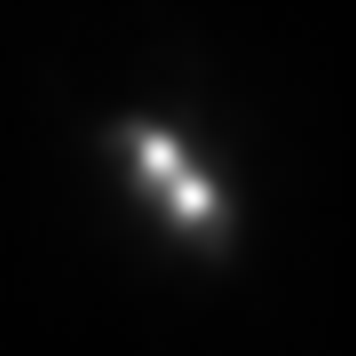Credit & Copyright: W. Merline (SwRI),
et al.
Explanation:
This eight-frame animation is based on the
first
ever images of a
double
asteroid!
Formerly thought to be a single enormous chunk of rock,
asteroid
90 Antiope resides in the
solar system's
main asteroid belt between Mars and Jupiter.
Now, these premier images reveal Antiope to actually consist of
two 50 mile wide asteroids separated by about 100 miles.
Like weights on each end of an elastic string,
the pair mutually orbit their center of mass, or balance
point in the space between them, once every 16.5 hours.
Binary asteroids and asteroids
with moons are believed
to be rare, but observations of their orbits allow a direct
determination of asteroid masses and densities.
Surprisingly, Antiope
and known
asteroid-moon systems are found
to have densities closer to ice than rock, despite their
relatively dark and unreflective surfaces.
These sharp images were made at the Keck Observatory
atop the Hawaiian volcano Mauna Kea
using newly developed adaptive optics technology to
overcome the
blurring effect of Earth's atmosphere.
1999 2000 2001 2002 2003 2004 2005 2006 2007 2008 2009 2010 2011 2012 2013 2014 2015 2016 2017 2018 2019 2020 2021 2022 2023 2024 2025 |
Январь Февраль Март Апрель Май Июнь Июль Август Сентябрь Октябрь Ноябрь Декабрь |
NASA Web Site Statements, Warnings, and Disclaimers
NASA Official: Jay Norris. Specific rights apply.
A service of: LHEA at NASA / GSFC
& Michigan Tech. U.
|
Публикации с ключевыми словами:
астероиды - binary asteroid - adaptive optics - двойные астероиды - адаптивная оптика - asteroid
Публикации со словами: астероиды - binary asteroid - adaptive optics - двойные астероиды - адаптивная оптика - asteroid | |
См. также:
Все публикации на ту же тему >> | |
